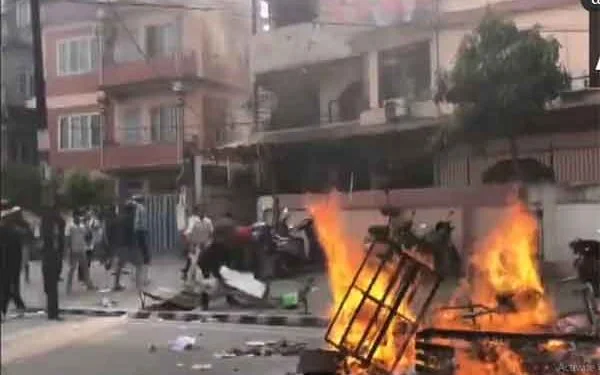Lagatar24 Desk
Kathmandu: Nepal witnessed violent unrest on Friday as thousands of royalist protesters demanding the restoration of monarchy and Hindu statehood clashed with police near Kathmandu’s international airport. Demonstrators shouted slogans like “Raja aao, desh bachao”, “Humein rajtantra wapas chahiye”, and “Corrupt government, down down”, while waving national flags and carrying photos of former King Gyanendra Shah.
The protest, which included participation from the Rastriya Prajatantra Party, turned violent when demonstrators broke through police barricades and pelted stones. In response, Nepal Police resorted to tear gas, water cannons, and aerial firing in Kathmandu’s Tinkune area. Several vehicles, a house, and a TV station were reportedly set ablaze. The CPN (Unified Socialist) party office was also attacked.
As tensions escalated, the Nepali Army was deployed, and a curfew was imposed in Tinkune, Sinamangal, and Koteshwor areas of the capital to contain the situation.
Royalist Sentiment Surges Again
Nepal abolished its 240-year-old monarchy in 2008 and transitioned into a secular, democratic republic. However, recent years have seen a resurgence of royalist sentiment, amplified by a video message from former King Gyanendra on Democracy Day (February 19) urging support for monarchy.
Pro-monarchy demonstrators had earlier held a rally on March 9, displaying posters of Uttar Pradesh Chief Minister Yogi Adityanath alongside King Gyanendra. Their slogan-heavy campaign criticizes the current government for corruption and governance failures.
Opposition Rally Counters Royalist Movement
In parallel, a large anti-monarchy gathering led by the Samajwadi Morcha and left parties like the Communist Party of Nepal (Maoist Centre) and CPN-Unified Socialist was held at Bhrikutimandap, where participants chanted, “Gantantra Zindabad” and “Rajtantra Murdabad”, demanding action against corruption and reiterating support for the republican system.
Royalist organizations have given the government a one-week ultimatum, indicating possible further escalation.









